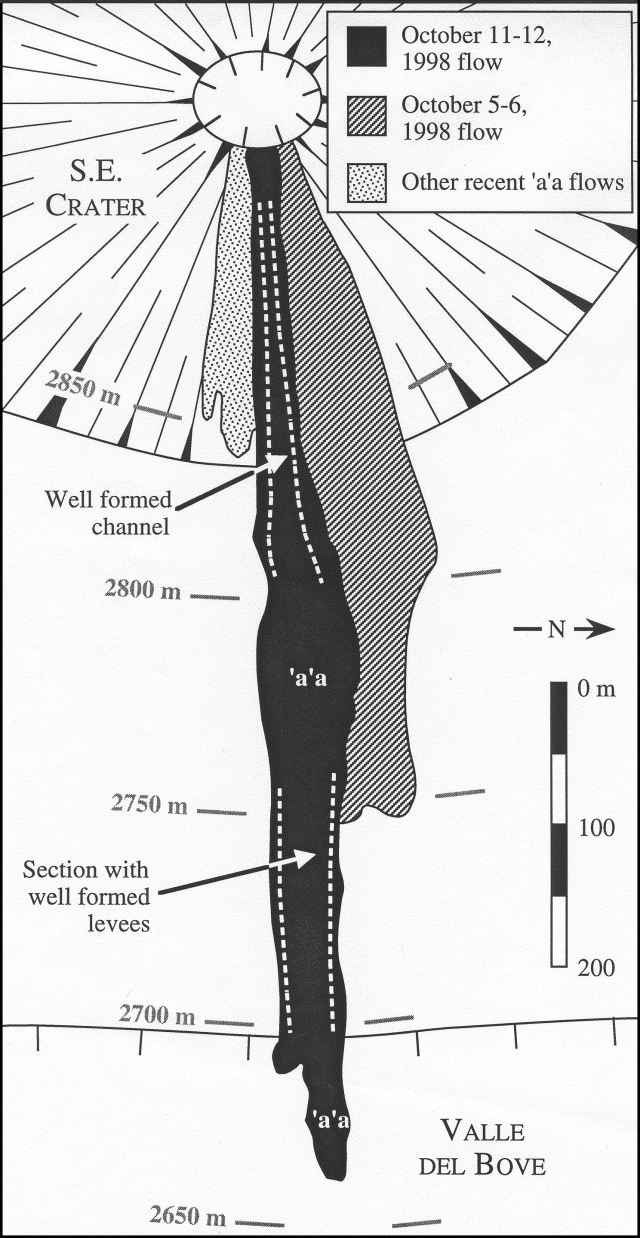Report on Etna (Italy) — March 1999
Bulletin of the Global Volcanism Network, vol. 24, no. 3 (March 1999)
Managing Editor: Richard Wunderman.
Etna (Italy) Additional details of mid-October 1998 activity at Southeast Crater
Please cite this report as:
Global Volcanism Program, 1999. Report on Etna (Italy) (Wunderman, R., ed.). Bulletin of the Global Volcanism Network, 24:3. Smithsonian Institution. https://doi.org/10.5479/si.GVP.BGVN199903-211060
Etna
Italy
37.748°N, 14.999°E; summit elev. 3357 m
All times are local (unless otherwise noted)
This report provides additional details of activity during 10-15 October 1998, along with a map of the lava flows emplaced at that time. These events were the seventh episode in a cycle of activity beginning on 15 September 1998. The cycle was characterized by periods of low or no activity interrupted by intense Strombolian fountains and lava flows at Southeast Crater (SEC) (BGVN 23:12). Observations of SEC between 1900 and 1920 on 10 October revealed Strombolian explosions which sent ejecta ~100 m above the crater rim approximately twice every 10 minutes. By 1800 on the 11th, observations from Nicolosi, ~15 km from SEC, indicated that Strombolian activity was increasing, with 16-17 explosions/minute sending ejecta to heights of ~200 m. By nightfall on the 11th, glow from the lava flow extending E from SEC was observed. Upon arrival at Torre del Filosofo (~1 km S of the SEC) at 1930, the explosions had increased to roughly one every 3 seconds and channelized aa lava proceeded down the E flank of SEC. Ejecta reached 100-300 m, typically landing within 300 m of the rim. By midnight, Strombolian activity was near-continuous. The lava fountaining was not Hawaiian in style because discrete explosions could be discerned.
By the morning of 12 October activity had declined to 6-12 explosions/minute, and by the morning of 14 October no explosions were observed. On 14 October, Harris, Sherman, and Wright mapped the flow emplaced during the night of 11-12 October (figure 76). The flow was a single-unit, ~750 m-long aa flow with distinct channelized and leveed portions in the proximal and medial sections. The distal section extended ~100 m into the Valle del Bove. Flow thicknesses were typically ~2 m, but levees were up to ~5 m high. Temperatures measured in cracks varied from 70 to 457 °C. The flow followed the S margin of another recent flow. The latter flow was presumably emplaced during 5-6 October and the highest temperature obtained on it was 55°C (BGVN 23:12). Measurements taken at this time indicated a length of ~500 m for the 5-6 October flow (figure 76).
Geological Summary. Mount Etna, towering above Catania on the island of Sicily, has one of the world's longest documented records of volcanism, dating back to 1500 BCE. Historical lava flows of basaltic composition cover much of the surface of this massive volcano, whose edifice is the highest and most voluminous in Italy. The Mongibello stratovolcano, truncated by several small calderas, was constructed during the late Pleistocene and Holocene over an older shield volcano. The most prominent morphological feature of Etna is the Valle del Bove, a 5 x 10 km caldera open to the east. Two styles of eruptive activity typically occur, sometimes simultaneously. Persistent explosive eruptions, sometimes with minor lava emissions, take place from one or more summit craters. Flank vents, typically with higher effusion rates, are less frequently active and originate from fissures that open progressively downward from near the summit (usually accompanied by Strombolian eruptions at the upper end). Cinder cones are commonly constructed over the vents of lower-flank lava flows. Lava flows extend to the foot of the volcano on all sides and have reached the sea over a broad area on the SE flank.
Information Contacts: Andrew Harris, HIGP/SOEST, University of Hawaii, 2525 Correa Road, Honolulu, HI 96822 USA; John Murray and Robert Wright, Department of Earth Sciences, The Open University, Milton Keynes, MK7 6AA, UK; Andrew George, Gwel an Bendra, Penhale Lane, St. Cleer, Liskeard, Cornwall, PL14 5EB, UK; Jon Hearn, 20 Ringwood Rd., Twerton, Bath BA2 3JJ, UK; Sarah Sherman, 3015A Alencastre Pl., Honolulu, HI 96816, USA.


